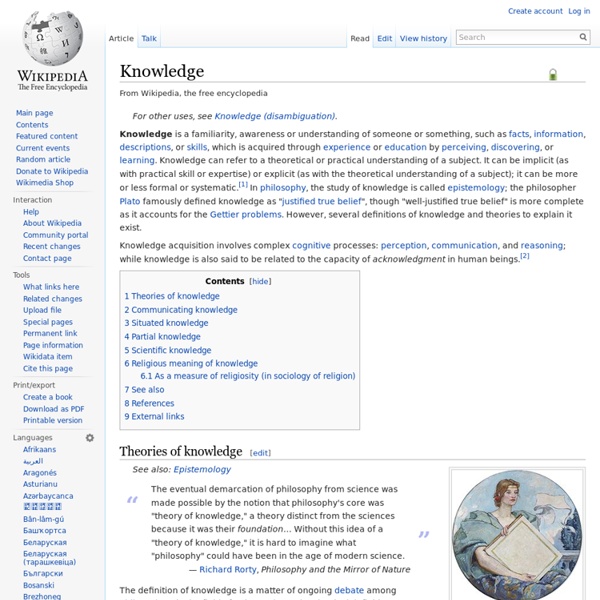Information
The ASCII codes for the word "Wikipedia" represented in binary, the numeral system most commonly used for encoding textual computer information In Thermodynamics, information is any kind of event that affects the state of a dynamic system that can interpret the information. Etymology[edit] The English word was apparently derived from the Latin stem (information-) of the nominative (informatio): this noun is derived from the verb informare (to inform) in the sense of "to give form to the mind", "to discipline", "instruct", "teach". The ancient Greek word for form was μορφή (morphe; cf. morph) and also εἶδος (eidos) "kind, idea, shape, set", the latter word was famously used in a technical philosophical sense by Plato (and later Aristotle) to denote the ideal identity or essence of something (see Theory of Forms). Information theory approach[edit] As sensory input[edit] Often information can be viewed as a type of input to an organism or system. As representation and complexity[edit]
Tacit knowledge
Tacit knowledge (as opposed to formal, codified or explicit knowledge) is the kind of knowledge that is difficult to transfer to another person by means of writing it down or verbalizing it. For example, stating to someone that London is in the United Kingdom is a piece of explicit knowledge that can be written down, transmitted, and understood by a recipient. However, the ability to speak a language, knead dough, use algebra,[1] or design and use complex equipment requires all sorts of knowledge that is not always known explicitly, even by expert practitioners, and which is difficult or impossible to explicitly transfer to other users. While tacit knowledge appears to be simple, it has far-reaching consequences and is not widely understood. Definition[edit] The term “tacit knowing” or “tacit knowledge” was first introduced into philosophy by Michael Polanyi in 1958 in his magnum opus Personal Knowledge. Tacit knowledge is not easily shared. Tacit knowledge vs. Transmission models[edit]
IB Diploma Theory of Knowledge course
Cognition
Cognition is a faculty for the processing of information, applying knowledge, and changing preferences. Cognition, or cognitive processes, can be natural or artificial, conscious or unconscious.[4] These processes are analyzed from different perspectives within different contexts, notably in the fields of linguistics, anesthesia, neuroscience, psychiatry, psychology, philosophy, anthropology, systemics, and computer science.[5][page needed] Within psychology or philosophy, the concept of cognition is closely related to abstract concepts such as mind, intelligence. It encompasses the mental functions, mental processes (thoughts), and states of intelligent entities (humans, collaborative groups, human organizations, highly autonomous machines, and artificial intelligences).[3] Etymology[edit] Origins[edit] Wilhelm Wundt (1832-1920) heavily emphasized the notion of what he called introspection; examining the inner feelings of an individual. Psychology[edit] Social process[edit] Serial position
Socrates
Socrates (/ˈsɒkrətiːz/;[2] Greek: Σωκράτης [sɔːkrátɛːs], Sōkrátēs; 470/469 – 399 BC)[1] was a classical Greek (Athenian) philosopher credited as one of the founders of Western philosophy. He is an enigmatic figure known chiefly through the accounts of classical writers, especially the writings of his students Plato and Xenophon and the plays of his contemporary Aristophanes. Plato's dialogues are among the most comprehensive accounts of Socrates to survive from antiquity, though it is unclear the degree to which Socrates himself is "hidden behind his 'best disciple', Plato".[3] Through his portrayal in Plato's dialogues, Socrates has become renowned for his contribution to the field of ethics, and it is this Platonic Socrates who lends his name to the concepts of Socratic irony and the Socratic method, or elenchus. Socratic problem Nothing written by Socrates remains extant. Socrates as a figure Socrates as a philosopher Biography Early life Military service Arrest of Leon Trial and death Notes
Sense
Five senses and the respective sensory organs An allegory of five senses. Still Life by Pieter Claesz, 1623. The painting illustrates the senses through musical instruments, a compass, a book, food and drink, a mirror, incense and an open perfume bottle. The tortoise could be a possible illustration of touch or an allusion to the opposite, screening of or shielding the senses (the tortoise isolating in its shell) A sense is a physiological capacity of organisms that provides data for perception. Humans have a multitude of senses. Definition[edit] A broadly acceptable definition of a sense would be "A system that consists of a group of sensory cell types that responds to a specific physical phenomenon, and that corresponds to a particular group of regions within the brain where the signals are received and interpreted." The senses are frequently divided into exteroceptive and interoceptive: Traditional senses[edit] Sight[edit] The inability to see is called blindness. Hearing[edit] Taste[edit]
The duality of knowledge
Abstract Knowledge Management (KM) is a field that has attracted much attention both in academic and practitioner circles. Most KM projects appear to be primarily concerned with knowledge that can be quantified and can be captured, codified and stored - an approach more deserving of the label Information Management.Recently there has been recognition that some knowledge cannot be quantified and cannot be captured, codified or stored. However, the predominant approach to the management of this knowledge remains to try to convert it to a form that can be handled using the 'traditional' approach.In this paper, we argue that this approach is flawed and some knowledge simply cannot be captured. Introduction It is clear from looking at the literature on knowledge management (KM) that the term knowledge suffers from a high degree of what might be called "terminological ambiguity" and often requires a host of adjectives to make clear exactly in what sense it is being used. "...highly personal.
Theory of Knowledge



